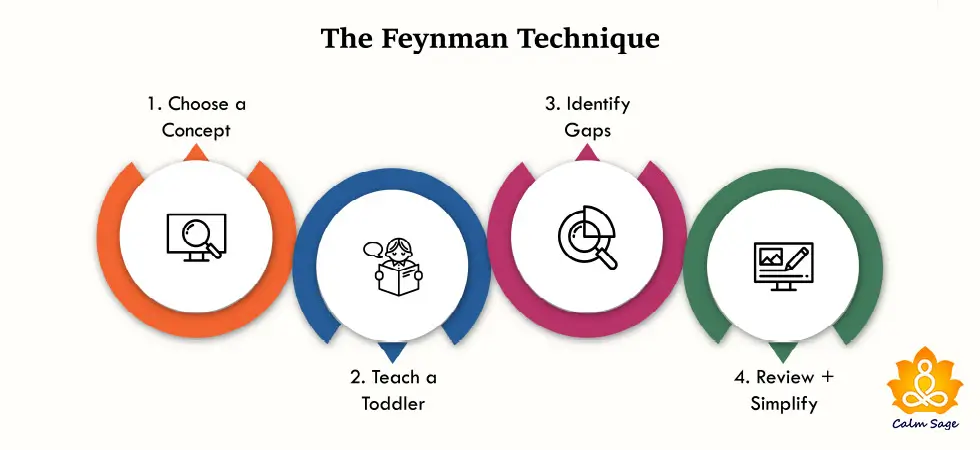Guide to the Feynman Learning Technique

For human development and growth, learning is paramount. It impacts an individual’s academic, professional, and personal success. This is why different learning methods are available, ranging from traditional cramming to new learning techniques, showcasing our diverse approaches to preserving and understanding information.
Amidst these is the Feynman Technique, an effective and simple method developed by Richard Feynman, a Nobel Prize-winning physicist. But what is this technique? How will it help? This is exactly what we at CalmSage today will discuss in this post.
What is Feynman’s Learning Technique?
It is a unique method of breaking down complex ideas into simple, understandable terms. The approach is similar to the teaching practice a teacher uses to teach students in the Feynman technique. First, the knowledge gaps are identified; after that, they are explained to make the concept clear and ingrained in the individual’s memory. This makes learning an active and engaging process rather than passively mugging up information.
In today’s busy world, where people memorize things without understanding them, this learning technique focuses on clarity, true comprehension, and simplicity. This helps individuals become subject matter experts and deeply understand whatever they are reading or learning. The difficult topics are broken into several subtopics, which makes learning easy and fun. There are four major steps to this learning method:
- Concept selection
- Interpretation is to be done in a way that can be taught to anyone.
- Identifying the gaps in understanding.
- Redefining the concept until it is well understood.
This means rather than giving the illusion of knowledge, the focus is on helping the individual genuinely grasp the subject matter. This involves questioning everything, simplifying explanations, and seeking a deeper understanding.
Core Principles of the Feynman Learning Technique
The Feynman Learning Technique works on three core principles that help reinforce understanding and help retain information.
1. Simplification
The core of the Feynman Technique is breaking information into small chunks and simplifying it. This makes identifying knowledge gaps and understanding the concept easy.
2. Active Recall
Recollecting information stored in memory strengthens neural connections and helps individuals shift learning to long-term memory. When the concepts in Feynman’s technique are taught aloud or by writing without looking at the notes, the brain is actively engaged, strengthening memory.
3. Iterative Learning
Revisiting the information or re-reading or re-learning the same concept repeatedly clears the doubts, reinforcing the learning process.
How to use the Feynman Learning Technique?
Choose a Concept
To learn or grasp information, topic selection is crucial. Once an individual has selected it, they can move ahead on the learning journey. The topic individuals select can be anything, from academic to professional to any skill that interests the person.
| Example: A person interested in physics might choose Newton’s Laws of Motion, while someone who is interested in drawing might choose color or fine arts. |
Teach It to a Child
Once the topic is selected, it should be explained in a very simplified manner. It should be like explaining a thing to a child who has no prior knowledge. Avoid using jargon or technical terms; use simple language.
| Example: When explaining Newton’s law of motion, instead of saying the first law explains an object remains at rest or in uniform motion unless acted upon by an external force, say, “Things are in motion unless pushed or still unless stopped. |
When explaining the colors, instead of saying to paint with a color combination, explain how colors complement each other and how one color enhances the other.
Identify Gaps in Your Knowledge
While teaching, one easily understands and discovers areas where understanding is weak or unclear. Identifying these gaps is essential, as a deep study is required to fill them and provide clear and concise information.
To spot gaps, you can self-question and ask yourself questions like “Why does this happen?” or “How does this connect to what I already know?”
Use the rubber duck method to understand where you get stuck. This will help understand where the gap is.
Teach others by highlighting parts you can’t explain clearly.
Review and Refine
After identifying the gaps, go back to your learning, fill the gaps, and use analogies or everyday comparisons to understand things in a simplified and straightforward manner.
| Example: Avoid describing photosynthesis in technical terms. Instead, explain it with an example of how sunlight can be used to cook food by lighting a fire, just as food cannot be cooked without fire. |
Simplify and Use Analogies
Make abstract concepts relatable through analogies. This will help memorize them and alter complex ideas into something familiar.
| Example: Compare public speaking to building a sandwich: You need two slices of bread to make a sandwich. Similarly, when speaking, you need an introduction and conclusion to keep the audience glued to what you are saying. |
Advantages of the Feynman Technique
- The Feynman Technique ensures a deep understanding of the subject matter with simple explanations. This method focuses on clarity, making it ideal for mastering complex topics.
- Memorization and retention are done actively. Learning is not passive; instead, its iterative nature reinforces knowledge.
- The illusion of knowledge is easily dealt with. Learners can identify the gaps and try to understand the topic until they can explain it. By finding gaps, the target can learn things that are moved to long-term memory.
Limitations of the Feynman Technique
- To understand a topic, simplifying it is required, but sometimes, this oversimplification deletes the required complexity in advanced fields such as mathematics or theoretical physics.
- Learners who love learning through visual aids or note-taking may not be able to accept the Feynman model, as they might find it less intuitive than other methods, such as mind mapping.
- Assessing others is easier than self-assessment. However, this technique lacks external feedback, which is required to understand progress.
How do you use the Feynman Technique in day-to-day life?
- Example 1: Academic Learning: A chemistry student can learn chemical bonding by simplifying things to “atoms sharing or stealing friends.”
- Example 2: Skill Mastery: An engineer can easily understand a complex algorithm for non-technical stakeholders by using visual aids and real-life examples.
What are some common mistakes to avoid when using the Feynman technique?
- Simplify the content, but don’t strip away core elements. Use analogies to keep the essence alive and explain it easily.
- Reviewing learning is a must. The minute you skip it, you miss learning. So, set reminders to review and refine your explanations.
- Understand the concept; focus on why. Avoid memorizing things without understanding; do not just focus on what.
- You learn better with real-world examples and applications. Always relate new knowledge to something familiar in your daily life.
Comparative Analysis: Feynman vs. Other Learning Methods
– Feynman vs. Active Recall: Active Recall is a learning process that involves actively stimulating memory during the learning process, often through questions and answers. It focuses on retrieving information, while Feynman emphasizes simplification and teaching, making it more holistic for understanding.
– Feynman vs. Spaced Repetition: Spaced repetition is a time-based learning technique that helps with memorization timing. It is highly effective for memorization, especially with facts and figures. Whereas Feynman aids in grasping the material deeply. Combining both can maximize learning outcomes.
Feynman vs, SQ3R (Survey, Question, Read, Recite, Review)
The SQ3R method improves reading comprehension and retention through a structured approach. It is systematic and thorough and can be time-consuming. Meanwhile, the Feynman technique emphasizes explanation and self-teaching.
Mind Mapping vs. Feynman
Mind Mapping is a visual learning method that organizes information in a diagram, showing relationships between concepts. It enhances creativity and is particularly useful for brainstorming and problem-solving. The Feynman Technique focuses on articulation and simplification.
Bloom’s Taxonomy vs. Feynman
Bloom’s Taxonomy is a hierarchical classification of learning objectives that guide educators in creating effective learning strategies. It encourages learners to progress from basic knowledge recall to higher levels of critical thinking. The Feynman Technique offers a specific process for enhancing understanding, particularly at the foundational levels of learning.
How to Combine Feynman with Other Methods
Blending different techniques optimizes learning outcomes. When the Feynman Technique with Spaced Repetition is combined, deep comprehension is guaranteed, while retention is reinforced. Similarly, when mind mapping and Feynman are clubbed, they enhance the visualization of complex concepts while focusing on simplification.
Furthermore, when other techniques are combined with Feynman, the hesitation that an individual might feel while explaining goes away, and there is deeper understanding of the concept, the individual instead of repeating things tries to understand it, and are able to logically connect aps. Also they are open to peer feedback to identify gaps, ask critical questions about the concept’s ‘why’ and ‘how’, and regularly revisit challenging sections to strengthen weak spots.
Conclusion
The guide explains the Feynman Technique and how it enhances the learning process. If you want to master certain skills and keep the learning ingrained, this method is for you. You can help others thoroughly understand the concept through this technique. Also, identifying gaps and self-analysis becomes easy.
Each learning method has advantages and disadvantages; therefore, when working with one model, combine it with others if you want better results. Feynman Technique excels in fostering understanding through simplification and teaching.
Other methods like SQ3R, Mind Mapping, and Spaced Repetition offer complementary benefits. The best way to keep learning and excelling is by combining techniques that suit individual learning needs and goals.
Frequently Asked Questions




















